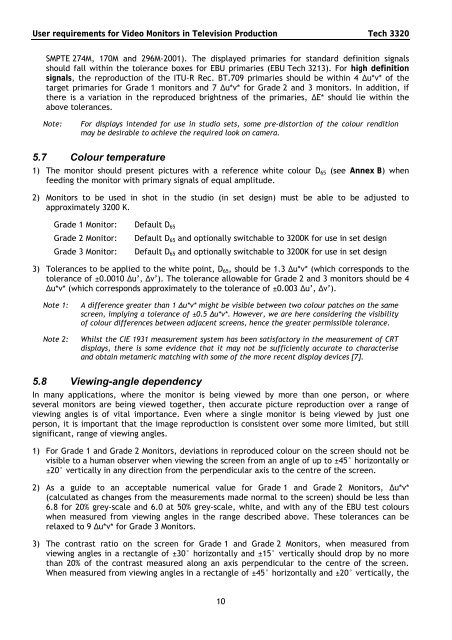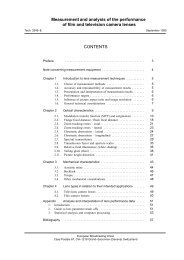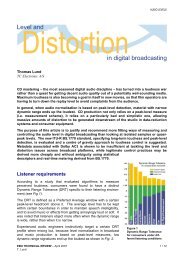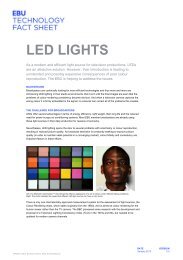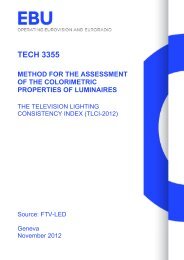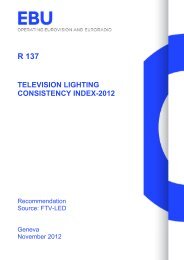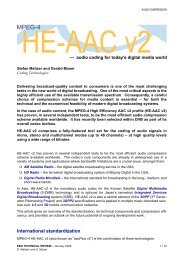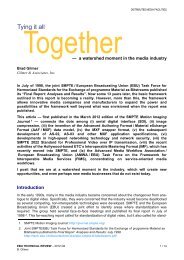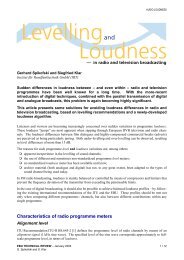User requirements for Video Monitors in Television ... - EBU Technical
User requirements for Video Monitors in Television ... - EBU Technical
User requirements for Video Monitors in Television ... - EBU Technical
You also want an ePaper? Increase the reach of your titles
YUMPU automatically turns print PDFs into web optimized ePapers that Google loves.
<strong>User</strong> <strong>requirements</strong> <strong>for</strong> <strong>Video</strong> <strong>Monitors</strong> <strong>in</strong> <strong>Television</strong> Production Tech 3320<br />
SMPTE 274M, 170M and 296M-2001). The displayed primaries <strong>for</strong> standard def<strong>in</strong>ition signals<br />
should fall with<strong>in</strong> the tolerance boxes <strong>for</strong> <strong>EBU</strong> primaries (<strong>EBU</strong> Tech 3213). For high def<strong>in</strong>ition<br />
signals, the reproduction of the ITU-R Rec. BT.709 primaries should be with<strong>in</strong> 4 ∆u*v* of the<br />
target primaries <strong>for</strong> Grade 1 monitors and 7 ∆u*v* <strong>for</strong> Grade 2 and 3 monitors. In addition, if<br />
there is a variation <strong>in</strong> the reproduced brightness of the primaries, ∆E* should lie with<strong>in</strong> the<br />
above tolerances.<br />
Note:<br />
For displays <strong>in</strong>tended <strong>for</strong> use <strong>in</strong> studio sets, some pre-distortion of the colour rendition<br />
may be desirable to achieve the required look on camera.<br />
5.7 Colour temperature<br />
1) The monitor should present pictures with a reference white colour D 65 (see Annex B) when<br />
feed<strong>in</strong>g the monitor with primary signals of equal amplitude.<br />
2) <strong>Monitors</strong> to be used <strong>in</strong> shot <strong>in</strong> the studio (<strong>in</strong> set design) must be able to be adjusted to<br />
approximately 3200 K.<br />
Grade 1 Monitor: Default D 65<br />
Grade 2 Monitor: Default D 65 and optionally switchable to 3200K <strong>for</strong> use <strong>in</strong> set design<br />
Grade 3 Monitor: Default D 65 and optionally switchable to 3200K <strong>for</strong> use <strong>in</strong> set design<br />
3) Tolerances to be applied to the white po<strong>in</strong>t, D 65 , should be 1.3 ∆u*v* (which corresponds to the<br />
tolerance of ±0.0010 ∆u’, ∆v’). The tolerance allowable <strong>for</strong> Grade 2 and 3 monitors should be 4<br />
∆u*v* (which corresponds approximately to the tolerance of ±0.003 ∆u’, ∆v’).<br />
Note 1:<br />
Note 2:<br />
A difference greater than 1 ∆u*v* might be visible between two colour patches on the same<br />
screen, imply<strong>in</strong>g a tolerance of ±0.5 ∆u*v*. However, we are here consider<strong>in</strong>g the visibility<br />
of colour differences between adjacent screens, hence the greater permissible tolerance.<br />
Whilst the CIE 1931 measurement system has been satisfactory <strong>in</strong> the measurement of CRT<br />
displays, there is some evidence that it may not be sufficiently accurate to characterise<br />
and obta<strong>in</strong> metameric match<strong>in</strong>g with some of the more recent display devices [7].<br />
5.8 View<strong>in</strong>g-angle dependency<br />
In many applications, where the monitor is be<strong>in</strong>g viewed by more than one person, or where<br />
several monitors are be<strong>in</strong>g viewed together, then accurate picture reproduction over a range of<br />
view<strong>in</strong>g angles is of vital importance. Even where a s<strong>in</strong>gle monitor is be<strong>in</strong>g viewed by just one<br />
person, it is important that the image reproduction is consistent over some more limited, but still<br />
significant, range of view<strong>in</strong>g angles.<br />
1) For Grade 1 and Grade 2 <strong>Monitors</strong>, deviations <strong>in</strong> reproduced colour on the screen should not be<br />
visible to a human observer when view<strong>in</strong>g the screen from an angle of up to ±45° horizontally or<br />
±20° vertically <strong>in</strong> any direction from the perpendicular axis to the centre of the screen.<br />
2) As a guide to an acceptable numerical value <strong>for</strong> Grade 1 and Grade 2 <strong>Monitors</strong>, ∆u*v*<br />
(calculated as changes from the measurements made normal to the screen) should be less than<br />
6.8 <strong>for</strong> 20% grey-scale and 6.0 at 50% grey-scale, white, and with any of the <strong>EBU</strong> test colours<br />
when measured from view<strong>in</strong>g angles <strong>in</strong> the range described above. These tolerances can be<br />
relaxed to 9 ∆u*v* <strong>for</strong> Grade 3 <strong>Monitors</strong>.<br />
3) The contrast ratio on the screen <strong>for</strong> Grade 1 and Grade 2 <strong>Monitors</strong>, when measured from<br />
view<strong>in</strong>g angles <strong>in</strong> a rectangle of ±30° horizontally and ±15° vertically should drop by no more<br />
than 20% of the contrast measured along an axis perpendicular to the centre of the screen.<br />
When measured from view<strong>in</strong>g angles <strong>in</strong> a rectangle of ±45° horizontally and ±20° vertically, the<br />
10


